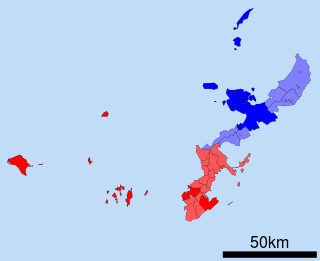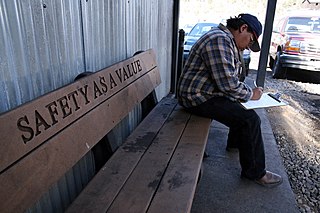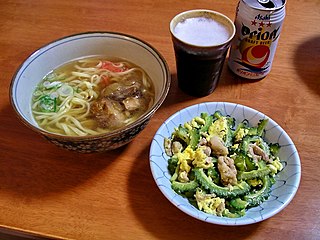Related Research Articles

Human life expectancy is a statistical measure of the estimate of the average remaining years of life at a given age. The most commonly used measure is life expectancy at birth. This can be defined in two ways. Cohort LEB is the mean length of life of a birth cohort and can be computed only for cohorts born so long ago that all their members have died. Period LEB is the mean length of life of a hypothetical cohort assumed to be exposed, from birth through death, to the mortality rates observed at a given year. National LEB figures reported by national agencies and international organizations for human populations are estimates of period LEB.

Okinawa Prefecture is a prefecture of Japan. Okinawa Prefecture is the southernmost and westernmost prefecture of Japan and has a population of 1,457,162 and a geographic area of 2,281 km2.

The Ryukyuan people are a Japonic-speaking East Asian ethnic group native to the Ryukyu Islands, which stretch between the islands of Kyushu and Taiwan. Administratively, they live in either the Okinawa Prefecture or the Kagoshima Prefecture within Japan. They speak one of the Ryukyuan languages, considered to be one of the two branches of the Japonic language family, the other being Japanese and its dialects. Hachijō is sometimes considered by linguists to constitute a third branch.

The Okinawan language or Central Okinawan is a Northern Ryukyuan language spoken primarily in the southern half of the island of Okinawa, as well as in the surrounding islands of Kerama, Kumejima, Tonaki, Aguni and a number of smaller peripheral islands. Central Okinawan distinguishes itself from the speech of Northern Okinawa, which is classified independently as the Kunigami language. Both languages are listed by UNESCO as endangered.
A centenarian is a person who has reached the age of 100 years. Because life expectancies worldwide are below 100, the term is invariably associated with longevity. The United Nations in 2012 estimated that there were 316,600 living centenarians worldwide.

The Okinawa diet describes the traditional dietary practices of indigenous people of the Ryukyu Islands, which were claimed to have contributed to their relative longevity over a period of study in the 20th century.

Diseases of affluence, previously called diseases of rich people, is a term sometimes given to selected diseases and other health conditions which are commonly thought to be a result of increasing wealth in a society. Also referred to as the "Western disease" paradigm, these diseases are in contrast to so-called "diseases of poverty", which largely result from and contribute to human impoverishment. These diseases of affluence have vastly increased in prevalence since the end of World War II.
Type A and Type B personality hypothesis describes two contrasting personality types. In this hypothesis, personalities that are more competitive, highly organized, ambitious, impatient, highly aware of time management, or aggressive are labeled Type A, while more relaxed, "receptive", less "neurotic" and "frantic" personalities are labeled Type B.

Screening, in medicine, is a strategy used to look for as-yet-unrecognised conditions or risk markers. This testing can be applied to individuals or to a whole population without symptoms or signs of the disease being screened.

Okinawan cuisine is the cuisine of the Okinawa Prefecture of Japan. The cuisine is also known as Ryūkyūan cuisine, a reference to the Ryukyu Kingdom. Due to differences in culture, historical contact between other regions, climate, vegetables and other ingredients, Okinawan cuisine differs from mainland Japanese cuisine.
Blue zones are regions in the world where people are claimed to live longer than average. Examples of blue zones include Okinawa Prefecture, Japan, Nuoro Province, Sardinia, Italy, the Nicoya Peninsula, Costa Rica, and Icaria, Greece. The name "blue zones" derived simply during the original survey by scientists who "used a blue pen on a map to mark the villages with long-lived population."

Japan has the highest proportion of elderly citizens of any country in the world. 2014 estimates showed that about 38% of the Japanese population was above the age of 60, and 25.9% was above the age of 65, a figure that increased to 29.1% by 2022. By 2050, an estimated one-third of the population in Japan is expected to be 65 and older.
Health care services in Nepal are provided by both public and private sectors and are generally regarded as failing to meet international standards. Prevalence of disease is significantly higher in Nepal than in other South Asian countries, especially in rural areas. Moreover, the country's topographical and sociological diversity results in periodic epidemics of infectious diseases, epizootics and natural hazards such as floods, forest fires, landslides, and earthquakes. But, recent surge in Non communicable diseases has emerged as the main public health concern and this accounts for more than two-thirds of total mortality in country. A large section of the population, particularly those living in rural poverty, are at risk of infection and mortality by communicable diseases, malnutrition and other health-related events. Nevertheless, some improvements in health care can be witnessed; most notably, there has been significant improvement in the field of maternal health. These improvements include:
Social epidemiology focuses on the patterns in morbidity and mortality rates that emerge as a result of social characteristics. While an individual's lifestyle choices or family history may place him or her at an increased risk for developing certain illnesses, there are social inequalities in health that cannot be explained by individual factors. Variations in health outcomes in the United States are attributed to several social characteristics, such as gender, race, socioeconomic status, the environment, and educational attainment. Inequalities in any or all of these social categories can contribute to health disparities, with some groups placed at an increased risk for acquiring chronic diseases than others.
Ikigai is a Japanese concept referring to something that gives a person a sense of purpose, a reason for living.
A centenarian is a person who has attained the age of 100 years or more. Research on centenarians has become more common with clinical and general population studies now having been conducted in France, Hungary, Japan, Italy, Finland, Denmark, the United States, and China. Centenarians are the second fastest-growing demographic in much of the developed world. By 2030, it is expected that there will be around a million centenarians worldwide. In the United States, a 2010 Census Bureau report found that more than 80 percent of centenarians are women.
Rapes during the occupation of Japan were war rapes or rapes committed under the Allied military occupation of Japan. Allied troops committed a number of rapes during the Battle of Okinawa during the last months of the Pacific War and the subsequent occupation of Japan. The Allies occupied Japan until 1952 following the end of World War II and Okinawa Prefecture remained under US governance for two decades after. Estimates of the incidence of sexual violence by Allied occupation personnel differ considerably.
Hara hachi bun me (腹八分目) is a Confucian teaching that instructs people to eat until they are 80 percent full. The Japanese phrase translates to, "Eat until you are eight parts full", or "belly 80 percent full".
Sogen Kato was a Japanese man thought to have been Tokyo's oldest man until July 2010, when his mummified corpse was found in his bedroom. It was concluded he had likely died in November 1978, aged 79, and his family had never announced his death. Relatives had rebuffed attempts by ward officials to see Kato in preparations for Respect for the Aged Day later that year, citing many reasons from him being a "human vegetable" to becoming a sokushinbutsu. An autopsy could not determine the cause of Kato's death.
Research into food preferences in older adults and seniors considers how people's dietary experiences change with ageing, and helps people understand how taste, nutrition, and food choices can change throughout one's lifetime; particularly when people approach the age of 70, or beyond. Influencing variables can include: social and cultural environment, gender and/or personal habits, and also physical and mental health. Scientific studies have been performed to explain why people like or dislike certain foods and what factors may affect these preferences.
References
- 1 2 Want to live to be 100? The Guardian newspaper. Published June 7, 2001. Accessed February 8, 2009.
- ↑ Bernstein, Adam; Willcox, Tamaki; et al. (2004). "First Autopsy Study of an Okinawan Centenarian: Absence of Many Age-Related Diseases". Journal of Gerontology: Medical Sciences. 59A (11): 1195–1199.